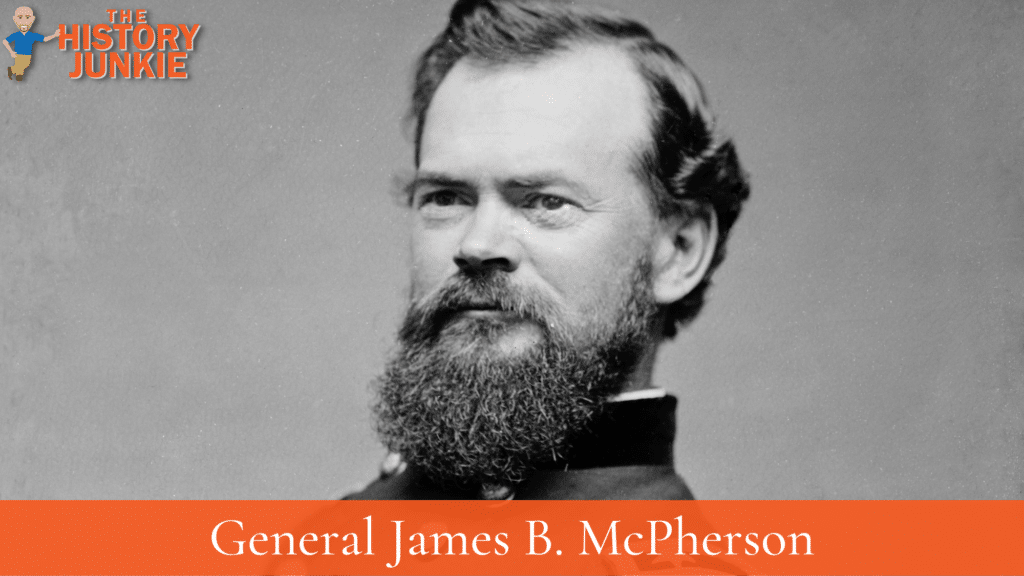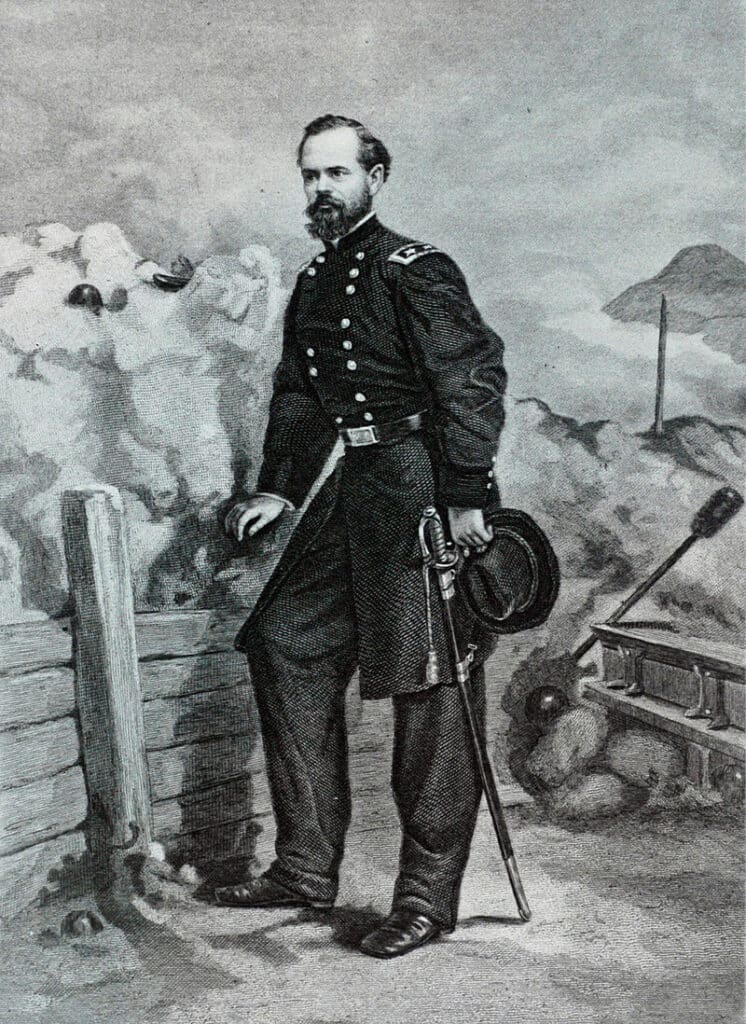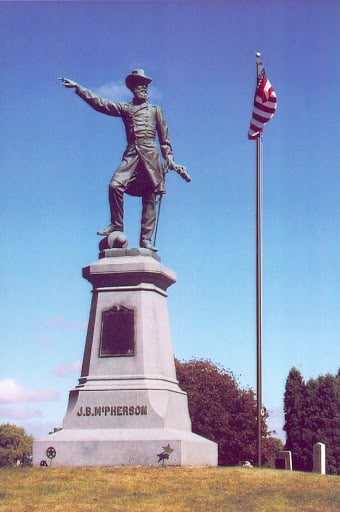General James B. McPherson was a popular Union General in the Civil War who served under Henry Halleck, Ulysses S. Grant, and William T. Sherman. He had seen much success and was rising in renown when he was killed at the Battle of Atlanta by his former classmate John Bell Hood.

He had served with distinction at the Battle of Shiloh and was a key figure in Sherman's March to the Sea.
Jump to:
Early Life
James B. McPherson was born in Clyde, Ohio. He attended a small academy in Norwalk, Ohio, and from there went to the United States Military Academy.
He graduated from West Point in 1853 at the top of his class. Afterward, McPherson was appointed to the Corps of Engineers with the rank of brevet second lieutenant.
He quickly moved up the rank and became an assistant instructor of practical engineering at the academy. This was the first time an officer so young reached this position.
James B. McPherson's career prior to the Civil War continued to impress. He assisted in building up the defenses in New York and improved the Hudson River.
He participated in the construction of Fort Delaware and was one of the lead engineers who designed the defenses of Alcatraz Island off the coast of San Francisco.
While in San Francisco, He met and began to court a woman by the name of Emily Hoffman. Emily's mother was a Confederate sympathizer in Baltimore, Maryland, and did not want her daughter to get involved with a Union soldier, let alone a rising Union officer. The two were engaged, but their marriage was delayed due to the beginning of the Civil War.
Civil War
At the beginning of the Civil War, McPherson was still stationed in San Francisco, California. Unlikely to see much action and further his career, he put in a request to be transferred to the Corps of Engineers in the East.
On August 1, 1861, he left California for New York and became part of the staff that served Major General Henry Halleck. Soon, he was sent to St. Louis, Missouri, where he was appointed command of the Department of the West.
His skill as an engineer would draw the attention of Ulysses S. Grant. He would soon serve under him and help plan the successful captures of Forts Henry and Donelson. He would later serve alongside William Sherman in the Battle of Shiloh.
After serving with distinction and proving himself as a valuable asset, McPherson was promoted to brigadier general.
Following the Battle of Shiloh, which lasted from April 6–7, he was promoted to brigadier general. On October 8, he was promoted to major general and was soon after given command of the XVII Corps in Grant's Army of the Tennessee.
In September 1862, McPherson assumed a position on the staff of General Grant. For his bravery at Corinth, he was promoted to major-general, dating from October 8, rising to that position solely on merit. Immediately after the siege of Vicksburg in which McPherson commanded the center, on Grant's recommendation, McPherson was confirmed a brigadier general in the regular army, dating from August 1, 1863. Soon after this promotion, McPherson led a column of infantry into Mississippi and repulsed the enemy at Canton.

On March 12, 1864, he was given command of the Army of the Tennessee after its former commander, Maj. Gen. William T. Sherman was promoted to command of all armies in the West.
He then requested leave to go home and marry his fiancé Emily Hoffman in Baltimore, Maryland. His leave was initially granted but quickly revoked by Sherman, who explained McPherson was needed for his upcoming Atlanta Campaign.
McPherson's army was the Right Wing of Sherman's army, alongside the Army of the Cumberland and the Army of the Ohio.
Sherman planned to have the bulk of his forces feint toward Dalton, Georgia, while McPherson would bear the brunt of Confederate General Joseph E. Johnston's attack and attempt to trap them.
However, the Confederate forces eventually escaped, and Sherman blamed McPherson (for being "slow"), although it was mainly faulty planning on Sherman's part that led to the escape. McPherson's troops followed the Confederates "vigorously" and were resupplied at Kingston, Georgia.
The troops drew near Pumpkinvine Creek, where they attacked and drove the Confederates from Dallas, Georgia, even before Sherman's order to do so. Johnston and Sherman maneuvered against each other until the Union's tactical defeat at the Battle of Kennesaw Mountain.
McPherson then tried a flanking maneuver at the Battle of Marietta, but that failed as well.
Confederate President Jefferson Davis became frustrated with Johnston's strategy of maneuver and retreat, and on July 17 replaced with Lt. Gen. John Bell Hood. With the Union armies closing in on Atlanta, Hood first attacked George Henry Thomas's Army of the Cumberland north of the city on July 20 at Peachtree Creek, hoping to drive Thomas back before other forces could come to his aid. The attack failed.
Then Hood's cavalry reported that the left flank of McPherson's Army of the Tennessee, east of Atlanta, was unprotected. Hood visualized a glorious replay of Jackson's famous flank attack at Chancellorsville and ordered a new attack.
McPherson had advanced his troops into Decatur, Georgia, and from there, they moved onto the high ground on Bald Hill overlooking Atlanta. Sherman believed that the Confederates had been defeated and were evacuating; however, McPherson rightly believed that they were moving to attack the Union left and rear.
On July 22, while they were discussing this new development, however, four Confederate divisions under Lt. Gen. William J. Hardee flanked Union Maj. Gen. Grenville Dodge's XVI Corps.
While McPherson was riding his horse toward his old XVII Corps, a line of Confederate skirmishers appeared, yelling, "Halt!". McPherson raised his hand to his head as if to remove his hat but suddenly wheeled his horse, attempting to escape.
The Confederates opened fire and mortally wounded McPherson in the back. When the Confederate troops approached and asked his orderly who the downed officer was, the aide replied, "Sir, it is General McPherson. You have killed the best man in our army."
Legacy
When General Sherman was given the news of McPherson's fate, he wept. His heart went out to McPherson's fiancé, who was waiting for him to return. In great sorrow, Sherman penned this letter to send to Emily Hoffman:
My Dear Young Lady, A letter from your Mother to General Barry on my Staff reminds me that I owe you heartfelt sympathy and a sacred duty of recording the fame of one of our Country's brightest and most glorious Characters. I yield to none on Earth but yourself the right to excel me in lamentations for our Dead Hero. Why should d****'s darts reach the young and brilliant instead of older men who could better have been spared?
Some say that James B. McPherson would have become a major political player had he stayed alive.
Emily Hoffman never married and died in 1891.
McPherson is buried in Clyde, Ohio, in a cemetery named in his honor. A statue of him is in the center of the cemetery that overlooks the main street.
The McPherson House is located across the street from the cemetery.

